Health
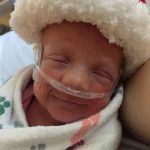
 It hardly seems possible that it can be two years ago already, that our family’s little Reece Balcerzak arrived in what was destined to be the beginning of a long time away from home for her parents, while they waited in Denver for their daughter to get strong enough to go home. It was a tough time, with an amazing ending. The little family came home victoriously with their precious girl. I guess that makes her middle name very much appropriate…Victoria, which means “victory” in Latin.
It hardly seems possible that it can be two years ago already, that our family’s little Reece Balcerzak arrived in what was destined to be the beginning of a long time away from home for her parents, while they waited in Denver for their daughter to get strong enough to go home. It was a tough time, with an amazing ending. The little family came home victoriously with their precious girl. I guess that makes her middle name very much appropriate…Victoria, which means “victory” in Latin.
Reece has so much more going for her than just her name, however. The little girl is not only a fighter, but she smiles more than just about anyone else I have ever seen. It is amazing that a little girl who has been through such a tough beginning can be so filled with joy, but then I guess that it was her parents and family who actually went through all that. Reece was just there, smiling at everyone through it all. Even as a tiny…and I really mean tiny…girl, she was filled with joy and always smiling. I find that so awesome!!
Since her very early arrival at 28 weeks into her mother, Katie’s pregnancy, Reece has been going at break-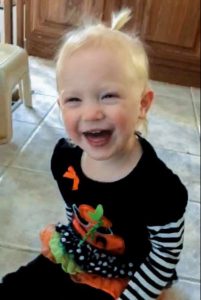
 neck speed to make up for the time she spend in the hospital in Denver. She is a very busy little girl. She never ceases to amaze all who know her. Her parents don’t really need much in the way of entertainment, because their daughter is really good at that. She is talking very well now, and chatters about the things that interest her, some of which we probably have no idea, because they are her happy things alone. Ahhh, the life of a child. To have such innocence, and such joy with the things around you. Reece has such a bright future ahead of her…so many things to learn and to explore. It will be exciting for us, her family, to watch this happy, smiley girl as she grows into the wonderful adult she will one day become. Keep smiling smiley girl. We love it. Today is Reece’s 2nd birthday. Happy birthday Reece. Have a great day!! We love you!!
neck speed to make up for the time she spend in the hospital in Denver. She is a very busy little girl. She never ceases to amaze all who know her. Her parents don’t really need much in the way of entertainment, because their daughter is really good at that. She is talking very well now, and chatters about the things that interest her, some of which we probably have no idea, because they are her happy things alone. Ahhh, the life of a child. To have such innocence, and such joy with the things around you. Reece has such a bright future ahead of her…so many things to learn and to explore. It will be exciting for us, her family, to watch this happy, smiley girl as she grows into the wonderful adult she will one day become. Keep smiling smiley girl. We love it. Today is Reece’s 2nd birthday. Happy birthday Reece. Have a great day!! We love you!!

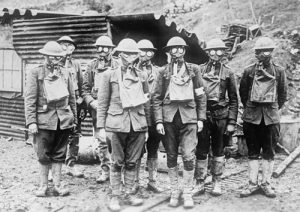 As nursing goes, I suppose you could say that World War I changed everything. War is an ugly business, and wounded men (and women these days) are just a part of the unavoidable side effects of it. As the upheaval of World War I changed the world, so the horrors of it, changed nursing.
As nursing goes, I suppose you could say that World War I changed everything. War is an ugly business, and wounded men (and women these days) are just a part of the unavoidable side effects of it. As the upheaval of World War I changed the world, so the horrors of it, changed nursing.
From 1914 to 1918, what was dubbed “the war to end all wars” in the innocence of the times, anyway…led to the mobilization of more than 70 million military personnel, including 60 million Europeans, making it one of the largest wars in history. As we know, it was hardly the war to end all wars, but it did change many of the things we had come to expect war to be. World War I was one of the deadliest conflicts in history. The death toll is staggering…estimated nine million combatants and seven million civilian deaths, as a direct result of the war. To add to that total, came the resulting genocides, as well as the 1918 influenza pandemic, which caused another 50 to 100 million deaths worldwide.
Now, just imagine being a nurse in those days. Of course, medical tents and hospitals were close to the perimeter of the fighting, to care for hurt soldiers quickly. This assured that the World War I nurses were witness to the conflict firsthand. I seriously doubt if any of them walked away from the war with less PTSD than the soldiers did. Many of them wrote about their involvement in diaries and letters that, similar to photographs from this time, offer insight into how they were personally impacted. The journals also include details about fighting, disease, and the hope that nurses and soldiers alike found in their darkest moments…if there could be any hope to be found.
It was in World War I that Germany introduced gas as a new form of aggression in 1915. It was in many ways the latest form of terrorism. To say that it was a different level of engagement seems an understatement. Gas devices became commonplace. They were worn anytime an air raid siren sounded, and some people wore them much of the time, as a precaution. The soldiers didn’t go anywhere without their gas mask. It was their life-line. Still, they were among the most feared elements of World War I.
“Sister Edith Appleton was a British nurse who served in France during World War I. She wrote about the soldiers stricken by gas and the adverse physical impacts they endured. The minimal immediate effects are tearing of the eyes, but subsequently, it causes build-up of fluid in the lungs, known as pulmonary edema, leading to death. It is estimated that as many as 85% of the 91,000 gas deaths in WWI were a result of phosgene or the related agent, diphosgene (trichloromethane chloroformate).”
Margaret Trevenen Arnold, a volunteer British Red Cross nurse in France in 1915 kept a diary of her time at Le Tréport and described “groans, and moans, and shouts, and half-dazed mutterings, and men with trephined heads suddenly sitting bolt upright… It was awful, and I really know now what [conflict] means.” These serious head injuries would most likely cause permanent brain damage for these men…if they survived at all.
Some hospital tents were eerily quiet, because the men in them were too sick to make a sound. Bandages were changed as often as every two hours, in an effort to ward off infection, and tourniquets to stop the bleeding until the soldier could be sent to surgery. Most of these field “hospitals” faced the same serious conditions…a lack of clean water and sterile surroundings. The nurses had to make due with what they had…and that often wasn’t much. Sometimes the lack of medicine became a major issue, especially when it came to anesthesia. Sometimes, the soldier had to simply force himself to remain calm, and steel himself to the inevitable pain of the surgery. These men had to place their faith in the doctors and nurses who cared for them, and they had not had time to even prepare for the need for surgery…let alone without anesthesia.
“Violet Gosset served on the Western Front from 1915 to 1919. While working at a hospital in Boulogne, France, Gosset kept notes about her experiences. She described a lack of supplies, overcrowded conditions, and scrapes that often resulted from a lack of adequate protection.”
“Helen Dare Boylston, an American nurse who served in France with the Harvard Unit medical team, had patients that spanned a wide range of age demographics. Some of the soldiers were just teenagers (“boys”), while others were in their 20s. However, Boylston recalled at least one soldier in his 60s (she called him “Dad”). Boylston saw the number of men in her care rise significantly in March 1918. At this time, she was sent…with two other nurses…to care for 500 soldiers. Boylston and her fellow nurses, including one named Ruth, quickly adapted to their conditions.”
Trench warfare was a shock to most of the soldiers. Still, most soldiers remained in good spirits. A part of nursing that might be considered a little different in the field hospitals is that the nurses are “in charge of” morale to a great degree. whether the men had Trench Foot, were sick, or wounded, they needed to have someone to lift their spirits. Who would have ever thought of nurses as morale boosters, but it was so.
Flu was widespread during World War I, even before the pandemic of 1918. After the pandemic began, things became critical. Now, nurses had to contend with treatment and prevention, in addition to other issues. One problem is that soldiers who ended up in medical tents and hospitals were often covered in mud, and flies frequently buzzed around them. Keeping germs at bay was next to impossible.
“Nurse Helen Dare Boylston was a keen observer of how soldiers reacted when they returned from the front, especially when they interacted with female nurses. She commented on the “fascinating game” of casual 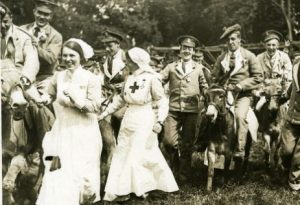
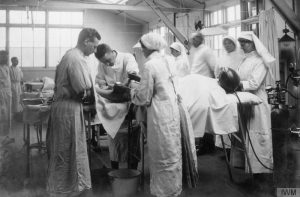 romance that commonly played out in the midst of conflict-related stress.” This was probably one of the most unusual phenomena, because nurses are told not to get emotionally involved, and yet here it was exactly what was needed. Nursing has changed over the years, but never has it been so evident as in World War I. It was as if nurses were making it up as they went along…and maybe they were.
romance that commonly played out in the midst of conflict-related stress.” This was probably one of the most unusual phenomena, because nurses are told not to get emotionally involved, and yet here it was exactly what was needed. Nursing has changed over the years, but never has it been so evident as in World War I. It was as if nurses were making it up as they went along…and maybe they were.
 It’s that time of year again, and Thanksgiving Day has arrived. The day will begin with much cooking, table setting, and other preparation. All too often we get so caught up in the preparation for the main meal of the day, and prepare for the gathering together of family and friends, that we forget the real purpose of the day…giving thanks for all we have been given.
It’s that time of year again, and Thanksgiving Day has arrived. The day will begin with much cooking, table setting, and other preparation. All too often we get so caught up in the preparation for the main meal of the day, and prepare for the gathering together of family and friends, that we forget the real purpose of the day…giving thanks for all we have been given.
Over the past year, some health issues have presented themselves, not only in our family, with my husband, Bob; but with my son-in-law, Kevin’s mother, Becky Skelton too. Both of them had heart issues, and now both of them are well again. You can’t emphasize too much, the importance of good health. Never is that importance made more clear, than when things happen that threaten that good health. The concerns we have all felt, each of us watching as another of our loved ones has worried over their mom or dad, husband or wife, brother or sister, were almost overwhelming. Now, that all the tests, the surgery, the procedure, and the recovery are behind us, we feel only thankfulness.
Our daughter, Corrie has been working hard in nursing school, and doing very well. She has been so blessed 
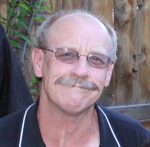 with great grades, and a wonderful nursing school experience. I have watched her blossom throughout this process, and it warms my heart to see such an amazing transformation in her. She and Kevin have also been blessed with a granddaughter, who is their son, Chris and fiancée, Karen’s daughter. Their son Josh is very busy with two jobs, while waiting for the next college class that he needs to become an EMT. Eventually he will be going into firefighting.
with great grades, and a wonderful nursing school experience. I have watched her blossom throughout this process, and it warms my heart to see such an amazing transformation in her. She and Kevin have also been blessed with a granddaughter, who is their son, Chris and fiancée, Karen’s daughter. Their son Josh is very busy with two jobs, while waiting for the next college class that he needs to become an EMT. Eventually he will be going into firefighting.
Bob and I have been thankful to have been able to travel to visit our daughter Amy Royce and her family, and spend two weeks with them, including Independence Day, which was a new thing for us, since we have spent Independence Day in the Black Hills for many years. Spending quality time with Amy; Travis; Shai and her boyfriend, Jordan; and Caalab, and his girlfriend, Chloe, was a special time. Any amount of time spent with family is something to be thankful for. As our children, grandchildren, and now great granddaughter grow and become more busy, time is something that is often in short supply, and definitely a blessing.
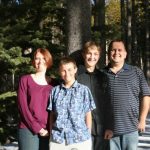

Everyone has different reasons to be thankful all year long, but at this time of year, we tend to reflect on the many blessings we have been given all year…some are extra special, and others bring deep emotion, because we know what we might have lost. This Thanksgiving Day, I realize just how much I have to be thankful for, and for all of it, I thank God, the Father of Lights, from whom all good gifts come. I hope everyone has as much to be thankful for as I have this year. Happy Thanksgiving to all.
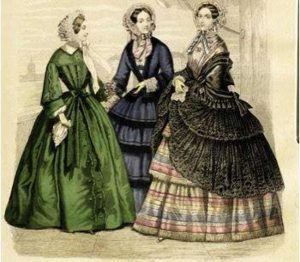
 Women have always had an eye for fashion, but I can’t say that having an “eye” for fashion, is the same as having common sense for fashion. In the Victorian era, Bottle-green dresses were all the rage. I understand the love of the color green, and how a beautiful emerald green might be a coveted color. The problem occurs with the process of obtaining that color. The process used to achieve this lovely shade of green involved the fabric being dyed using large amounts of arsenic…yes, rat poison!! Some women suffered nausea, impaired vision, and skin reactions to the dye. They endured the suffering because the dresses were only worn on special occasions, thereby limiting exposure to the arsenic in the fabric. By contrast, it was the garment makers were the real sufferers. Many of them became very ill and even died to bring this trend to the fashionable set.
Women have always had an eye for fashion, but I can’t say that having an “eye” for fashion, is the same as having common sense for fashion. In the Victorian era, Bottle-green dresses were all the rage. I understand the love of the color green, and how a beautiful emerald green might be a coveted color. The problem occurs with the process of obtaining that color. The process used to achieve this lovely shade of green involved the fabric being dyed using large amounts of arsenic…yes, rat poison!! Some women suffered nausea, impaired vision, and skin reactions to the dye. They endured the suffering because the dresses were only worn on special occasions, thereby limiting exposure to the arsenic in the fabric. By contrast, it was the garment makers were the real sufferers. Many of them became very ill and even died to bring this trend to the fashionable set.
Another crazy style was known as Panniers, which comes from the French word “panier,” meaning “basket.” These were popular in the 17th and 18th centuries. The look involved a boxed petticoat to expanded the width of skirts and dresses. The contraption stood out on either side of the waistline…straight out!! Panniers varied in size and were made of whalebone, wood, metal, and sometimes reeds. Extremely large panniers were worn mostly on special occasions and reflected the wearer’s social status. Even the servants wore them, though in a much smaller version. Two women couldn’t walk through an entrance at the same time or sit on a couch together, because their panniers took up an entire extra seat or more. The device was also uncomfortable, limiting movement and activity.
In the 1910s, French designer Paul Poiret, who was well known as “The King of Fashion” in America, debuted the hobble skirt. The long, close-fitting skirts forced women who wore them to adopt mincing, tiny steps. True, Poiret’s design liberated women from heavy petticoats and constricting corsets. But as he said, “Yes, I freed the 
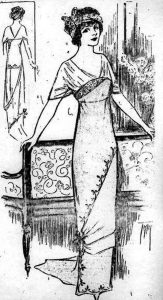 bust. But I shackled the legs.” This makes me wonder why women allow their fashion ideas to come from men…who don’t have to wear the clothes they design. Some of these “fashions” were enough to make a woman faint, because her corset was too tight, and she could not get sufficient air.
bust. But I shackled the legs.” This makes me wonder why women allow their fashion ideas to come from men…who don’t have to wear the clothes they design. Some of these “fashions” were enough to make a woman faint, because her corset was too tight, and she could not get sufficient air.
During the Roaring ’20s, women no longer wanted the hourglass shape. Now the style was the boyish flapper figure. Underwear had to change to assist in this new look, and women who were “busty,” had a big problem and the underwear needed a big overhaul. The goal of every undergarment was to flatten the breasts and torso, so that flapper dresses could hang straight down without any curvaceous interruptions. Corset-makers R. and W.H. Symington invented a garment, the Symington Side Lacer, that would flatten the breasts. The wearer would slip the garment over her head and pull the straps and side laces tight to smooth out curves. Other manufacturers designed similar devices. The Miracle Reducing Rubber Brassiere was “scientifically designed without bones or lacings,” while the Bramley Corsele combined the brassiere and corset into one piece that easily layered under dresses. I wonder how anyone could breathe in these prisons known as underwear.
The Crinoline, also known as the hoop skirt, was a bell-shaped device that pushed the volume of skirts to an extreme degree. Worn in the 1800s by Victorian women, Crinolines were originally petticoats made of linen stiffened with horsehair. Wonderful…now we are wearing horsehair under our skirts. This created a big problem. It was just too hot with so many petticoats. Later, the invention of the steel cage crinoline offered the same voluminous look without the extra heat and bulk of thick petticoats. These undergarments were clumsy and hard to control, but they were also dangerous. In 1858, a young woman in Boston died when her large skirt caught embers from a fireplace in her parlor and went up in flames. It all happened to fast to save her. Nineteen such deaths occurred in a two-month period. That is a heavy price to pay in the name of fashion.
And then, there was the “Grecian bend,” the Victorian bustle. It arrived on the scene in the 1870s. The earliest version of this trend simply featured excess fabric gathered and draped at the back of a dress. Eventually, though, skirts were puffed up with large cushions filled with straw. Ladies who wore them ended up with exaggerated figures with outthrust hindquarters. The bustle was frequently a target of ridicule. This style 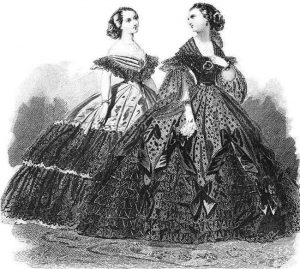
 reminds me of the “padded seat” of modern day leggings, though the modern day version isn’t quite so exaggerated. In 1868, Laura Redden Searing, using the pen name Howard Glyndon, wrote about the agony young women put themselves through for fashion in the New York Times, “If you knew the Spartan courage which is required to go through an ordeal of this sort for two or three hours at a time, you would not wonder that she has not an idea left in her head after her daily display is over,” she said. Hahahaha!! That sounds reasonable to me.
reminds me of the “padded seat” of modern day leggings, though the modern day version isn’t quite so exaggerated. In 1868, Laura Redden Searing, using the pen name Howard Glyndon, wrote about the agony young women put themselves through for fashion in the New York Times, “If you knew the Spartan courage which is required to go through an ordeal of this sort for two or three hours at a time, you would not wonder that she has not an idea left in her head after her daily display is over,” she said. Hahahaha!! That sounds reasonable to me.
 Marie Sklodowska was born in an era when women seldom got a very long education, if they got one at all. Born on November 7, 1867 in Warsaw (modern-day Poland). Sklodowska was the youngest of five children, following siblings Zosia, Józef, Bronya and Hela. Their parents were both teachers. Her father, Wladyslaw, was a math and physics instructor. When she was only 10, Sklodowska lost her mother, Bronislawa, to tuberculosis. Sklodowska, being a woman, probably should have grown up to be a wide and mother, dependent on her husband for everything…not that that is a horrible thing, because it isn’t, but it was not all she wanted. She had a good mind for Physics and Chemistry…both subjects were almost unheard of for women in those days.
Marie Sklodowska was born in an era when women seldom got a very long education, if they got one at all. Born on November 7, 1867 in Warsaw (modern-day Poland). Sklodowska was the youngest of five children, following siblings Zosia, Józef, Bronya and Hela. Their parents were both teachers. Her father, Wladyslaw, was a math and physics instructor. When she was only 10, Sklodowska lost her mother, Bronislawa, to tuberculosis. Sklodowska, being a woman, probably should have grown up to be a wide and mother, dependent on her husband for everything…not that that is a horrible thing, because it isn’t, but it was not all she wanted. She had a good mind for Physics and Chemistry…both subjects were almost unheard of for women in those days.
As a child, Sklodowska took after her father. She was bright and curious, and she excelled at school. Still, despite being a top student in her secondary school, she could not attend the men’s-only University of Warsaw. She instead continued her education in Warsaw’s “floating university,” a set of underground, informal classes held in secret. Both Marie and her sister, Bronya dreamed of going abroad to earn an official degree, but they lacked the financial resources to pay for more schooling. Sklodowska would not give up her dream. She worked out a deal with her sister, “She would work to support Bronya while she was in school, and Bronya would return the favor after she completed her studies.”
Sklodowska worked as a tutor and a governess for the next five years. She didn’t want to get behind, so she used her spare time to study…reading about physics, chemistry and math. Then in 1891, Sklodowska finally made her way to Paris and enrolled at the Sorbonne. She threw herself into her studies, but this dedication had a personal cost: with little money, Sklodowska survived on buttered bread and tea. Sometimes, her health suffered because of her poor diet. Nevertheless, Sklodowska completed her master’s degree in physics in 1893 and earned another degree in mathematics the following year.
You might be wondering exactly who Marie Sklodowska was, and why she was important. It might help to know that on July 26, 1895, Marie got married to French physicist, Pierre Curie. They were introduced by a colleague of Marie’s after she graduated from Sorbonne University. Marie had received a commission to perform a study on different types of steel and their magnetic properties and needed a lab for her work. As most people already know, she did her work at a great cost to her own health, but what most people probably don’t know, is that the radiation levels Curie was exposed to were so powerful that her notebooks must now be kept in lead-lined boxes, and it’s not just Curie’s manuscripts that are too dangerous to touch, either. If you visit the Pierre and Marie Curie collection at the Bibliotheque Nationale in France, many of her personal possessions…from her furniture to her cookbooks…require protective clothing to be safely handled. You’ll also have to sign a liability waiver, just in case.
In those days, things like radiation and it’s dangers were not known. Marie Curie was basically walking around with bottles of polonium and radium, both highly radioactive compounds, in her pockets all the time. She even kept capsules full of the dangerous chemicals on her shelf. “One of our joys was to go into our workroom at night; we then perceived on all sides the feebly luminous silhouettes of the bottles of capsules containing our products,” Marie, the Nobel Prize-winning scientist wrote in her autobiography. “It was really a lovely sight and one always new to us. The glowing tubes looked like faint, fairy lights.” In case you didn’t know, Marie Curie discovered radioactivity. Also, along with her husband, Pierre, they discovered the radioactive elements, Polonium and Radium, while working with the mineral, Pitchblende…a form of the mineral Uraninite occurring in 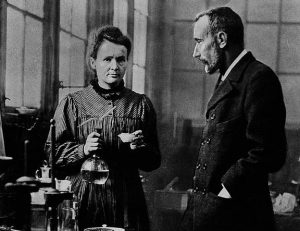 brown or black masses and containing radium. She also championed the development of X-rays, following her husband’s death in a street accident in Paris on 19 April 1906.
brown or black masses and containing radium. She also championed the development of X-rays, following her husband’s death in a street accident in Paris on 19 April 1906.
The fact that the notebook and related paraphernalia are still radioactive a century later is not as well known. The most common isotope of radium, the deadly chemical Curie carried in her pockets, has a half-life of 1,601 years. That said, people will not be able to go digging through the Curie’s library any time in this century, either. It is also known now, but wasn’t then, that the chemicals would end Curie’s life at a fairly early age. Curie died on July 4, 1934, of aplastic anemia, believed to be caused by prolonged exposure to radiation. She was 58 years old.

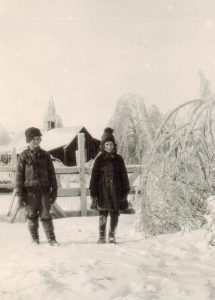 My Aunt Ruth Wolfe was the youngest of the four children of my grandparents, Allen and Anna Spencer. She was born on November 9, 1925 in Duluth, Minnesota. Strange to think that 31 years later, she would get a niece…me, who would be so much like her…in some ways that is. My Aunt Ruth was a very talented woman. She could play any instrument that was set before her, she could paint and do crafts, she loved horses and even raced them, and of course, she was an animal lover…all animals.
My Aunt Ruth Wolfe was the youngest of the four children of my grandparents, Allen and Anna Spencer. She was born on November 9, 1925 in Duluth, Minnesota. Strange to think that 31 years later, she would get a niece…me, who would be so much like her…in some ways that is. My Aunt Ruth was a very talented woman. She could play any instrument that was set before her, she could paint and do crafts, she loved horses and even raced them, and of course, she was an animal lover…all animals.
Aunt Ruth was never really one to want to settle in one place for very long…until she and Uncle Jim moved to the Spokane area, that is. Once they bought their mountain top outside of Newport, Washington, she knew she was home. The family built three cabins on the mountain top, one for Aunt Ruth and Uncle Jim; one for their daughter Shirley Cameron and her husband Shorty; and one for their son, Terry Wolfe. The beauty of the mountain lulled them into a quiet, peaceful life, far away from the hustle and bustle of the California area they had left behind after losing their son, Larry Wolfe to an accidental explosion. Nothing would bring him back, of course, but the peace of the mountain top helped to heal their wounded hearts.
Aunt Ruth and Uncle Jim, while very much at home on their mountain top, never lost their love of the open road, and often took trips to several location, including Casper, Wyoming to visit my family, her brother, Allen Spencer; sister-in-law, Collene; and daughters, Cheryl Masterson, Caryn Schulenberg, Caryl Reed, Alena 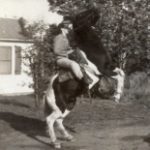
 Stevens, and Allyn Hadlock. We loved those visits. Aunt Ruth and Uncle Jim were always lots of fun, and having them in town again was a great treat. They had lived in the Casper area years before, and we were all very sad to see them move away. Those wonderful visits were cut short when Aunt Ruth became ill, and she passed away on May 11, 1992 of Cancer. Today would have been Aunt Ruth’s 94th birthday. Happy birthday in Heaven Aunt Ruth, I know you’re having a great celebration with all the loved ones who have now joined you there. We love and miss you very much.
Stevens, and Allyn Hadlock. We loved those visits. Aunt Ruth and Uncle Jim were always lots of fun, and having them in town again was a great treat. They had lived in the Casper area years before, and we were all very sad to see them move away. Those wonderful visits were cut short when Aunt Ruth became ill, and she passed away on May 11, 1992 of Cancer. Today would have been Aunt Ruth’s 94th birthday. Happy birthday in Heaven Aunt Ruth, I know you’re having a great celebration with all the loved ones who have now joined you there. We love and miss you very much.
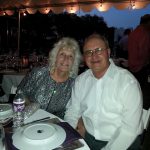 Birthdays are supposed to be happy events, and most are, but the birthdays that come after someone has passed away can be some of the hardest days we will ever spend. Losing a loved one leaves the family with nothing but empty space and memories. The place our loved one once filled with their presence, is now filled only with memories of someone who was, and still is, so important to us. Each first, as it arrives makes the emptiness even more pronounced. The first holiday, birthday, family dinner, or even just the mundane tasks they always helped with, are among the worst days of our new reality, but I think it is the first of those events that will always be viewed as the worst.
Birthdays are supposed to be happy events, and most are, but the birthdays that come after someone has passed away can be some of the hardest days we will ever spend. Losing a loved one leaves the family with nothing but empty space and memories. The place our loved one once filled with their presence, is now filled only with memories of someone who was, and still is, so important to us. Each first, as it arrives makes the emptiness even more pronounced. The first holiday, birthday, family dinner, or even just the mundane tasks they always helped with, are among the worst days of our new reality, but I think it is the first of those events that will always be viewed as the worst.
On October 16, 2019, our uncle, Eddie Hein had a heart attack while working in his 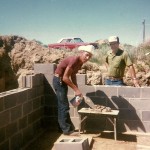 yard. Friends and neighbors, as will as his wife, Pearl and their grandson, Dalton, all tried to help, but it was too late. Eddie was gone, but his memory will be with his many friends and family members forever. Eddie was a sweet man with a heart of gold, who was always willing to help those in need. The people of Forsyth, Montana knew Eddie well. He was a friend to all. He would wave as he drove by, and help when it was needed. Eddie was known around town as someone who could always be counted on, no matter what the need. He was there to give a smile, a hug, a wave, or a hand. Someone said that Eddie was one of God’s great ones, and I agree.
yard. Friends and neighbors, as will as his wife, Pearl and their grandson, Dalton, all tried to help, but it was too late. Eddie was gone, but his memory will be with his many friends and family members forever. Eddie was a sweet man with a heart of gold, who was always willing to help those in need. The people of Forsyth, Montana knew Eddie well. He was a friend to all. He would wave as he drove by, and help when it was needed. Eddie was known around town as someone who could always be counted on, no matter what the need. He was there to give a smile, a hug, a wave, or a hand. Someone said that Eddie was one of God’s great ones, and I agree.
Eddie loved vintage cars, and had his own 55 Chevy that he thoroughly enjoyed. It wasn’t just the cars either,  because he loved old tractors too. Eddie loved living next to the Yellowstone River. It was almost like living in the country, and it gave them enough room to have their garden. Eddie could fix just about anything. He loved tinkering around in his shop. If you needed a part for something, there was a good chance that Eddie had it or could make it. He was a great carpenter, and could help build just about anything. Eddie was a bit of a Jock of all trades, and the people of Forsyth counted on him for many things. That is a big part of what makes his passing so sad for everyone, and the only consolation is that since Eddie was a Christian man, we know that we will see him again soon. Happy first Heavenly Birthday Eddie. We love and miss you very much.
because he loved old tractors too. Eddie loved living next to the Yellowstone River. It was almost like living in the country, and it gave them enough room to have their garden. Eddie could fix just about anything. He loved tinkering around in his shop. If you needed a part for something, there was a good chance that Eddie had it or could make it. He was a great carpenter, and could help build just about anything. Eddie was a bit of a Jock of all trades, and the people of Forsyth counted on him for many things. That is a big part of what makes his passing so sad for everyone, and the only consolation is that since Eddie was a Christian man, we know that we will see him again soon. Happy first Heavenly Birthday Eddie. We love and miss you very much.
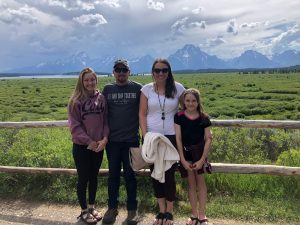
 When a person travels for business, they find that they really understand the importance of home. My niece, Susan Griffith is one of the many people who travel as part of their job. Susan works for Blue Cross Blue Shield of Wyoming, as a Client Development Executive, basically she is a health insurance agent. She travels to Cheyenne about twice a year around the time people have to update their insurance…open enrollment. She has to go for training. She has to travel around the Bighorn Basin for getting different companies signed up for Blue Cross. Because Susan has to travel for work, she knows how it feels to have to spend that time away from family. Everyone I have talked to about traveling for work has told me that they had little tricks to make a hotel room feel more like home. I don’t know if Susan has a way that helps her or not, but I do know that her home and her family are the most important things in her life. Nevertheless, travel time aside, Susan loves her job!!
When a person travels for business, they find that they really understand the importance of home. My niece, Susan Griffith is one of the many people who travel as part of their job. Susan works for Blue Cross Blue Shield of Wyoming, as a Client Development Executive, basically she is a health insurance agent. She travels to Cheyenne about twice a year around the time people have to update their insurance…open enrollment. She has to go for training. She has to travel around the Bighorn Basin for getting different companies signed up for Blue Cross. Because Susan has to travel for work, she knows how it feels to have to spend that time away from family. Everyone I have talked to about traveling for work has told me that they had little tricks to make a hotel room feel more like home. I don’t know if Susan has a way that helps her or not, but I do know that her home and her family are the most important things in her life. Nevertheless, travel time aside, Susan loves her job!!
Susan and her husband, Josh Griffith love to go camping in the mountains. They, like other members of her 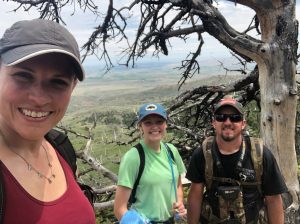
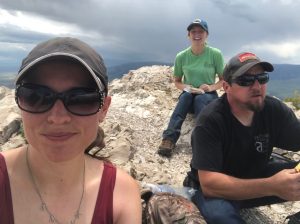 family, would live in the mountains, if it weren’t for jobs or school for their girls, Jala Satterwhite and Kaytlyn Griffith. They go camping every chance they get. They love to hike, and this year, they hiked Heart Mountain, which is relatively near their home in Powell, Wyoming. Heart Mountain gained world fame in World War II, when it was used as a concentration camp to hold Japanese-American citizen, after the attack on Pearl Harbor. Many people weren’t sure where Japanese-American loyalties lay, so the didn’t take a chance, and moved the people to camps. It was a sad, but understandable time. Susan’s family also hiked to Copper Lake in the Beartooth Mountains, but they don’t think they will try that one again, because in Susan’s own words, “It was crazy hard!!” This past year, they did something a little different too. San Diego can’t exactly be considered camping in the mountains. Nevertheless, they had a great time. They went to Sea World, and all the other great attractions of the area, including the ocean.
family, would live in the mountains, if it weren’t for jobs or school for their girls, Jala Satterwhite and Kaytlyn Griffith. They go camping every chance they get. They love to hike, and this year, they hiked Heart Mountain, which is relatively near their home in Powell, Wyoming. Heart Mountain gained world fame in World War II, when it was used as a concentration camp to hold Japanese-American citizen, after the attack on Pearl Harbor. Many people weren’t sure where Japanese-American loyalties lay, so the didn’t take a chance, and moved the people to camps. It was a sad, but understandable time. Susan’s family also hiked to Copper Lake in the Beartooth Mountains, but they don’t think they will try that one again, because in Susan’s own words, “It was crazy hard!!” This past year, they did something a little different too. San Diego can’t exactly be considered camping in the mountains. Nevertheless, they had a great time. They went to Sea World, and all the other great attractions of the area, including the ocean.
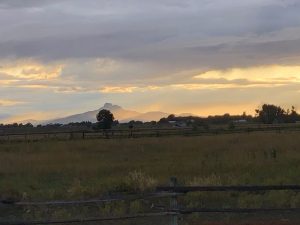
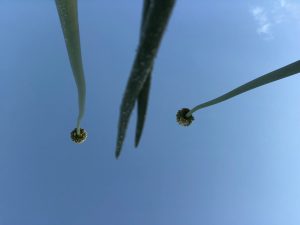 With all her traveling nearby, and far away, Susan somehow still finds time to grow a garden. This year, she had a good crop of onions and asparagus…just to name a couple. When she isn’t traveling or camping/hiking, Susan likes to be home. She enjoys nesting, and being with her family. In all, Susan lives a well rounded life, and finds herself very happy in it. Today is Susan’s birthday. Happy birthday Susan!! Have a great day!! We love you!!
With all her traveling nearby, and far away, Susan somehow still finds time to grow a garden. This year, she had a good crop of onions and asparagus…just to name a couple. When she isn’t traveling or camping/hiking, Susan likes to be home. She enjoys nesting, and being with her family. In all, Susan lives a well rounded life, and finds herself very happy in it. Today is Susan’s birthday. Happy birthday Susan!! Have a great day!! We love you!!
 On the first trip I made to Forsyth, Montana with my husband, Bob Schulenberg’s family, I was introduced to his family there…among them, Eddie Hein, Bob’s uncle…his dad’s half-brother. That first trip was followed by yearly trips for many years to come. We loved going up for visits, and we were always made to feel welcome. Eddie was a quiet man…soft spoken, but with a big heart. You always felt accepted by him. Eddie had a great big smile, and a laugh that lit up his face, and he liked to laugh. I will miss his smile, and his big hearted kindness. There was never the formality of calling Eddie and Pearl, uncle and aunt, because they weren’t that much older than many of their nieces and nephews were. Even though we didn’t see them as much lately as we used too, it was always good knowing that he was there. Now, suddenly, Eddie is gone. He passed away yesterday, even though it seemed that his health was improving after his stroke of a few years ago. We will all miss him very much.
On the first trip I made to Forsyth, Montana with my husband, Bob Schulenberg’s family, I was introduced to his family there…among them, Eddie Hein, Bob’s uncle…his dad’s half-brother. That first trip was followed by yearly trips for many years to come. We loved going up for visits, and we were always made to feel welcome. Eddie was a quiet man…soft spoken, but with a big heart. You always felt accepted by him. Eddie had a great big smile, and a laugh that lit up his face, and he liked to laugh. I will miss his smile, and his big hearted kindness. There was never the formality of calling Eddie and Pearl, uncle and aunt, because they weren’t that much older than many of their nieces and nephews were. Even though we didn’t see them as much lately as we used too, it was always good knowing that he was there. Now, suddenly, Eddie is gone. He passed away yesterday, even though it seemed that his health was improving after his stroke of a few years ago. We will all miss him very much.
Bob and I went to Forsyth, two years ago, after his stroke, and I am so glad that we made that trip. It is a trip I will cherish now. Eddie and Pearl, his wife, were both is good spirits, and the trip was so much fun. His mobility was good, even after the stroke, and he seemed just like his old self. I was glad. Pearl just beamed. She was so happy to have him beside her…something I understand after my own husband’s heart attack. You learn to set aside things that don’t matter so much, and live for the day you are in. That’s what Eddie and Pearl were doing too. There were times that Pearl wanted to declutter…we all need to do that from time to time, but  Eddie wanted her to let that go, and just be together. I think I understand where he was coming from, as I’m sure Pearl does too. Stuff can be cleaned out anytime, but time cannot be relived. Memories are always with us, but we have to live them to have them first, to make the memories. Eddie and Pearl lived them.
Eddie wanted her to let that go, and just be together. I think I understand where he was coming from, as I’m sure Pearl does too. Stuff can be cleaned out anytime, but time cannot be relived. Memories are always with us, but we have to live them to have them first, to make the memories. Eddie and Pearl lived them.
They were married on July 15, 1967, and their marriage was blessed with two children, Larry on May 17, 1969; and Kim on June 27, 1971. Life was good. Eddie worked for many years at Peabody Coal in Colstrip, Montana; while Pearl worked at the IGA in Forsyth, until they both retired. This past July they celebrated their 52 wedding anniversary. Eddie and Pearl had a house in Forsyth, Montana, along the Yellowstone River. They raised vegetables, and Pearl canned they every year. Eddie had a garage where he could tinker, and he loved caring for the garden. He was also a capable carpenter. He turned their mobile home into a beautiful house, with a fireplace made from area stone. It was beautiful. Eddie was always willing to help other people with their own projects, including when his brother, Walt Schulenberg, my father-in-law was building his house outside of Casper, Wyoming. As the years passed, Eddie and Pearl became grandparents. They loved their time with those kids, and I’m sure the kids loved the time with them.

It’s hard to believe that Eddie is gone now. There will always be an empty place that belonged to him. I am thankful for the memories of our trips to Forsyth, and the wonderful visits to Eddie and Pearl’s house. I can picture it now, sitting around their table, drinking coffee, and listening to the stories of our lives. It didn’t matter what we talked about…their lives or our lives, we were reconnecting, and that always felt good. I will really miss those times. It saddens me to have the aunts and uncles leaving us. They contribute so much to our lives, and that rich heritage is slipping away with each one who goes home to Heaven. Still, Eddie, like so many others who have gone on before us, is in our future now, not our past. We will see him again. Rest in peace Eddie. We love and miss you already.
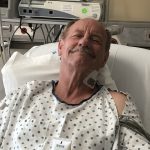
 One year ago today, my husband, Bob Schulenberg had a heart attack. It was one of the worst days of my life, and one of the best days of my life. I will never forget the scene after a man knocked on my car window in the parking lot at Walmart, asking me if “I know this man?” I immediately jumped out of my car and walked around the back of it, to be greeted with the worst scene of my life. Lying there on the pavement, bleeding from his head, was my precious husband. His eyes were open, but they were blank, and his skin was turning purple. After thinking I was going to lose him right there, I shook my head and said, “No!!” Getting down on the ground, I said, “Come on Bob…come on!!” Willing him to fight.
One year ago today, my husband, Bob Schulenberg had a heart attack. It was one of the worst days of my life, and one of the best days of my life. I will never forget the scene after a man knocked on my car window in the parking lot at Walmart, asking me if “I know this man?” I immediately jumped out of my car and walked around the back of it, to be greeted with the worst scene of my life. Lying there on the pavement, bleeding from his head, was my precious husband. His eyes were open, but they were blank, and his skin was turning purple. After thinking I was going to lose him right there, I shook my head and said, “No!!” Getting down on the ground, I said, “Come on Bob…come on!!” Willing him to fight.
It was then that a Wyoming Medical Center, Progressive Care Unit, cardiac care nurse showed up. Ginger Sims took charge. She started checking vitals, and immediately saw that he wasn’t breathing. She turned him over and began CPR. It had been maybe a minute since his heart attack. Suddenly, I could see that there was a swarm of people there to help Bob…each one orchestrated by God to be there at that very moment, some of them who never shopped at Walmart. Sean Pesicka-Taggart saw Bob fall, and came to him immediately. It was Sean who first alerted Ginger to the problem, when she saw him trying to help Bob. After beginning CPR, and tiring of doing compressions, Laura Lance, Sean’s girlfriend, and a transport worker at WMC, told Ginger that she knew CPR and could spell her. Ginger wasn’t sure, but she needed a break. Laura took over, and Ginger could see that she did know CPR. Sean had called 911, and got help coming. Then, as she was leaving the Walmart parking lot, another nurse, Valya Boycheva, who was also a friend of Ginger’s saw someone doing CPR, and turned her car around to come back and took turns doing CPR. Ginger heard me talking to Bob, and said if I knew him, I could do rescue breathing for him. I did, with instruction. It’s amazing how quickly your mind checks out when you are in this kind of situation. I had no idea what to do, even though I should have. The next thing I knew, the fire department was there. They hooked Bob up to the Lucas Machine, which does compression automatically. Bob was loaded into the ambulance, and I went along with him. Our fireman friend, Jerod Levin brought our car to the hospital for me.
As people were leaving Walmart, a number of them, saw all this and began praying…Chelsea and Zack Kessler; Chelsea called her parents and my friends, Page and Donna LePage; a member of my church, Lori Desanti; my boss, Jim Stengel; who called Donna LePage to pray, at which point she knew who she had already been praying for. The Cath Lab at WMC was staffed by people who knew Bob…he worked on their cars…Sam Cann and John Cooke, working with Dr Pickrell and Dr Hiser, who put a stent in Bob’s heart. From heart attack, to stent and functioning heart, took just 2 hours. This was a miracle of God, and we were very blessed with more time together.
That was one year ago today. This day, October 14, 2019, Bob’s 1st Heart Re-Birthday, is a very different kind of day. This day we will go to workout at the Nerd Center at WMC, where Bob has been in maintenance since his cardiac rehab was finished. We did a lot of walking before that horrible day last year, and they say that is why Bob’s heart has done so well. I agree, but God healed his heart. There in no other explanation for me.
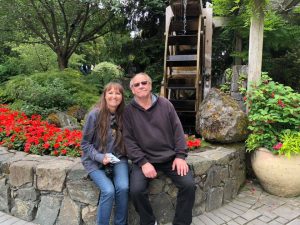
One might expect it to take a long time for Bob to heal, but it didn’t. He is completely back to normal now, and our lives continue on as usual…except that we truly know what we have. There is nothing that will make you appreciate your spouse more than almost losing them. It makes you realize just how blessed you are. We want to thank each and every one of the people involved in this miracle. With God’s help and your willing hearts, you all beat the Widowmaker, and we are forever grateful. Today is Bob’s 1st Heart Re-Birthday. It is an amazing day…the day that the Lord has made. We will rejoice today and be very glad in it. Happy 1st Heart Re-Birthday Bob!! We all love you!!

